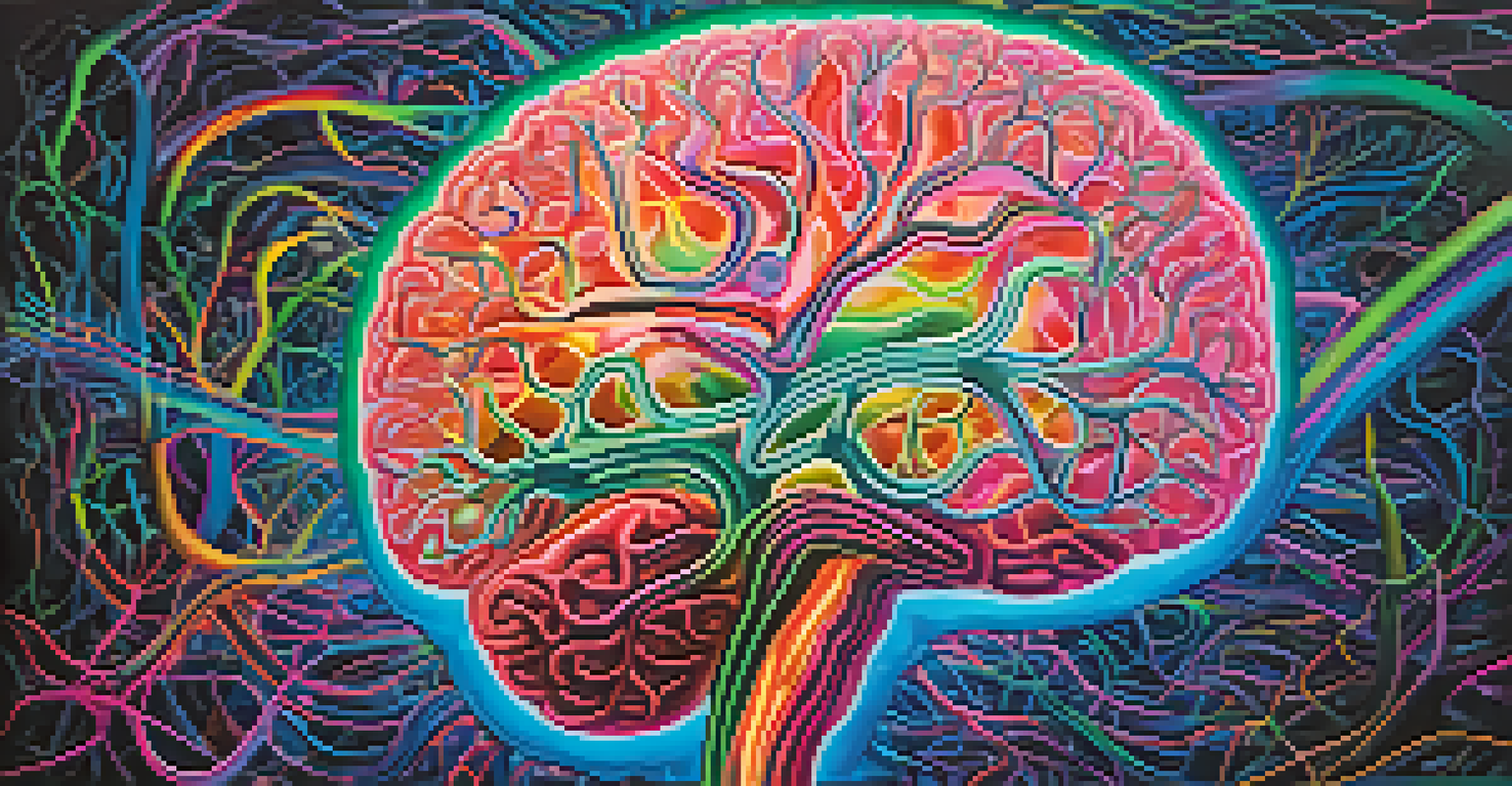Exploring Hallucinogens' Potential in Mental Health Therapy

Understanding Hallucinogens and Their Effects
Hallucinogens are substances that can alter perception, mood, and cognitive processes. Common examples include psilocybin, found in magic mushrooms, and LSD, which has been used in various therapeutic contexts. These substances can lead to profound changes in awareness and thought patterns, which is why they are garnering attention in mental health therapy.
Psychedelics have the potential to unlock the mind’s healing capacity, offering new pathways for understanding and recovery.
The effects of hallucinogens can vary widely from person to person, often depending on the dosage and the individual's mindset. Many users report experiencing heightened emotions, vivid visualizations, and a sense of interconnectedness with their surroundings. This unique mental state can potentially unlock new pathways for healing in individuals who have not found success with traditional treatments.
However, it’s essential to approach hallucinogens with caution. While they hold promise, the experiences can also be overwhelming or distressing for some. Understanding these nuances is crucial as researchers explore their therapeutic potential.
Historical Context of Hallucinogens in Therapy
The use of hallucinogens in therapeutic settings is not a new concept; it dates back to ancient cultures that utilized these substances in religious and healing rituals. For instance, indigenous peoples in the Americas have long used peyote and ayahuasca for spiritual and medicinal purposes. This historical backdrop sets the stage for modern scientific investigations into their benefits.

In the mid-20th century, psychedelics like LSD became popular in psychotherapy, particularly for treating anxiety, depression, and PTSD. However, due to societal backlash and the rise of strict regulations, research dwindled. It wasn’t until recently that a resurgence of interest has prompted scientists to reevaluate these substances' therapeutic properties.
Therapeutic Potential of Hallucinogens
Hallucinogens like psilocybin and LSD are showing promise in treating mental health conditions by unlocking new pathways for healing.
This historical context is critical as it shows that the potential for healing through hallucinogens has been recognized for centuries. It highlights the need for a balanced understanding of both their risks and rewards in contemporary mental health treatment.
Current Research on Hallucinogens and Mental Health
Today, a growing body of research is investigating the efficacy of hallucinogens in treating various mental health conditions, including depression, anxiety, and PTSD. For example, studies have shown that psilocybin can lead to significant reductions in depression symptoms, sometimes even after a single dose. This has spurred interest in how these substances can complement existing treatment modalities.
The therapeutic use of psychedelics is a journey into the self, often leading to profound insights and emotional breakthroughs.
Additionally, researchers are exploring how hallucinogens might enhance neuroplasticity—the brain's ability to adapt and reorganize itself. This could be particularly beneficial for individuals with mental health conditions that have been resistant to traditional therapies. By promoting new connections in the brain, hallucinogens may help patients process traumatic experiences more effectively.
While promising, it's important to note that much of this research is still in its early stages. Rigorous clinical trials are necessary to fully understand the potential benefits and risks associated with these substances, ensuring they can be safely integrated into therapeutic practices.
Mechanisms of Action in the Brain
The way hallucinogens work in the brain is complex and fascinating. They primarily act on serotonin receptors, particularly the 5-HT2A receptor, which plays a significant role in mood regulation and perception. By binding to these receptors, hallucinogens can alter the usual pathways of communication in the brain, leading to their characteristic effects.
This alteration can result in a heightened sense of connection and introspection, which many users find therapeutic. For instance, individuals with depression may experience a shift in perspective, allowing them to confront their struggles in a new light. Such shifts can lead to breakthroughs in understanding and managing their mental health.
Historical Use in Healing Practices
The use of hallucinogens in therapy has roots in ancient cultures, highlighting a long-recognized potential for healing.
Furthermore, ongoing research is delving into how these substances can promote long-lasting changes in brain function. Understanding these mechanisms is crucial for harnessing the full therapeutic potential of hallucinogens and integrating them into mainstream mental health treatments.
Safety and Ethical Considerations
As the interest in hallucinogens grows, so does the conversation around safety and ethics. While many studies report positive outcomes, it's vital to ensure that these substances are used responsibly and under professional supervision. Risks such as psychological distress, substance misuse, and negative experiences during sessions must be carefully managed.
Ethical considerations also come into play when discussing access and equity in treatment. As these therapies gain traction, ensuring that they are available to diverse populations is essential. This includes addressing any stigma associated with hallucinogen use and providing education about their potential benefits and risks.
Ultimately, establishing a framework for safe and ethical use is crucial as we explore hallucinogens' role in mental health therapy. A responsible approach can help maximize their benefits while minimizing potential harms.
Personal Anecdotes and Patient Experiences
Many individuals who have undergone hallucinogen-assisted therapy share transformative experiences that significantly impacted their mental health. For example, some report feeling a profound sense of peace and understanding after a session, leading to lasting improvements in their mood and outlook on life. These personal anecdotes often highlight the potential of hallucinogens to facilitate deep emotional healing.
Patients frequently describe moments of clarity and insight during their sessions, allowing them to confront issues they had struggled with for years. This can include revisiting traumatic memories with a new perspective, ultimately promoting healing. Such stories emphasize the unique ways hallucinogens can aid in processing complex emotions.
Safety and Ethical Considerations
As interest in hallucinogens grows, ensuring their responsible use and access to diverse populations is crucial for effective therapy.
However, it's important to remember that experiences can vary widely. While many find relief and clarity, others may encounter challenging emotions or confusion. This variability underscores the necessity of professional guidance and support throughout the therapeutic process.
The Future of Hallucinogens in Mental Health Therapy
Looking ahead, the future of hallucinogens in mental health therapy is promising yet uncertain. As research continues to unfold, we may see these substances integrated into standard treatment protocols for various mental health conditions. This could revolutionize how we approach mental health care, offering new hope for individuals who have found little relief through traditional methods.
Additionally, increased acceptance and understanding of psychedelics could lead to more open dialogues about mental health and the potential benefits of unconventional treatments. This cultural shift may encourage more individuals to seek help without fear of stigma, ultimately improving mental health outcomes across the board.

However, ongoing research, ethical considerations, and patient safety must remain at the forefront as we navigate this evolving landscape. With careful exploration and responsible integration, hallucinogens could play a significant role in shaping the future of mental health therapy.